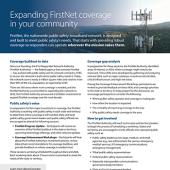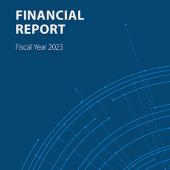Wildland fires continue to burn at all-time highs. From January to July 2021, more than 2.6 million acres were burned nationwide, including the massive, yet-to-be contained Bootleg Fire in Oregon. In 2020, nearly 59,000 wildfires burned more than 10 million acres. This was the second-most acreage impacted in a year since 1960, according to the National Interagency Coordination Center for wildland fires.
Since the launch of FirstNet in 2018, the network has become an important tool in the toolbox for wildland firefighters. We have seen tremendous interest and use of the FirstNet fleet of portable network assets for public safety agencies’ emergency response needs, with more than 750 requests from public safety in 2020.
At the First Responder Network Authority (FirstNet Authority), our goal is to support public safety in operationalizing their network, FirstNet, and ensure it continues to evolve to meet public safety’s communications needs. As part of our engagement efforts, we spoke to several wildland firefighters and agencies about lessons learned of using public safety broadband for combatting wildfires. Here are their takeaways and key things to keep in mind when it comes to using FirstNet to support the frontlines:
1. Know how to request FirstNet’s deployable assets for a Wildland Fire Incident
When disaster strikes, the FirstNet fleet of dedicated public safety deployables assets provides users with the ability to add FirstNet coverage and capacity where they need it most. FirstNet deployables can boost coverage areas to support wildfire incident command and response or increase capacity at base camps.
The fleet is made up of more than 100 deployable assets, like SatCOLTS, Compact Rapid Deployables, and Communications Vehicles, which are available to FirstNet subscribers 24/7 by request and at no extra charge. These mobile cell sites link to FirstNet via satellite, provide access to FirstNet’s Band 14 public safety spectrum, do not rely on commercial power availability, and provide similar capabilities and connectivity as a cell tower.
FirstNet has a dedicated team of customer service representatives available around the clock and ready to handle requests for deployables. If at all possible, fire teams are strongly encouraged to fill out a FirstNet Deployable Request form for an incident to ensure all operational requirements are clearly detailed. Requests can be submitted via email to the AT&T FirstNet Help Desk and by calling FirstNet Customer Service at 1-800-574-7000. Be prepared and have your FirstNet Agency Number (FAN) on hand.
For more tips on how to request a deployable, read our deployable factsheet.
2. Incorporate FirstNet into your agency’s standard operating procedures (SOPs)
Wildland firefighters are encouraged to incorporate procedures for FirstNet incident support into their SOPs. For example, fire teams can outline the process for requesting a FirstNet deployable asset and other FirstNet support in advance of an incident to prevent communication delays during a fire.
Here at the FirstNet Authority, we work together with public safety across the country to help them get the most benefit from their network. Fire agencies and personnel can take advantage of a series of opportunities offered by the FirstNet Authority to engage with us prior to wildland fire incidents to ensure teams are adequately supported. Through pre-incident planning and after action reviews, trainings, and other engagements, the FirstNet Authority can help you facilitate greater coordination and work through operational challenges for wildland firefighters in the field. Contact your FirstNet Authority Public Safety Advisor to learn more.
3. Pre-configure, update, and maintain devices
Whenever possible, public safety users are encouraged to pre-configure, update, and maintain devices prior to incidents to avoid challenges experienced on the fire scene. When firefighters enter austere or rural areas, devices can be difficult to remedy in a fast-paced incident response environment.
By updating firmware regularly, firefighters can ensure their devices can access FirstNet’s latest public safety features to enhance their user experience. Keeping devices updated can help you leverage area hotspots for data connectivity to applications, situational awareness tools, video conferencing, and printing.
4. Consider hotspots and train your team on using your cache of FirstNet devices, applications in advance
Agencies also told us FirstNet data solutions, such as hotspots, were important to operations. Hotspots were the main device used in remote camps with connectivity supported by a FirstNet deployable. In addition to routine operations, hot spots have been used to support virtual briefings for command staff from remote locations and to enable medical updates from spike camps in line with pandemic protocols for social distancing or quarantining.
For one Colorado agency, the procurement of a cache of FirstNet mobile devices was integral to operationalizing a situational awareness application for wildland firefighters during the Grizzly Creek fire. On FirstNet, firefighters leveraged a smartphone application to view incident maps, fire perimeter data, and reported firefighter location information every 129 seconds on average. Responders told us that knowing the location of firefighters vastly improved their operations.
FirstNet subscribers have access to a list of applications dedicated to public safety in the FirstNet App Catalog. If you download and/or purchase applications to meet your team’s specific needs, plan to integrate them in your cache of FirstNet devices prior to an incident to prevent potential tech related delays during a fire. Pre-incident preparedness should also include a staff training on the applications selected for use. Also, teams should make sure all applications are updated.
5. Know when and how to rely on FirstNet Central to extend priority access to supporting entities or gain situational awareness on network status
It's important to know how to access FirstNet Central, a centralized dashboard for FirstNet customers to manage their dedicated FirstNet services. This portal provides important tools for situational awareness and operations. Your access to FirstNet Central is provided by your agency. When an agency is assigned a FirstNet Account Number, an agency employee is also identified as an administrator for the account.
A FirstNet user who has been provided with access to FirstNet Central by his or her agency administrator can then go into the portal and access tools, such as the Network Status Tool. This feature allows users to view current network outages and to set alerts for notification of unplanned network outages in the future. For wildfire response, knowing where communications might be a challenge in the incident area ahead of time can provide the additional situational awareness your team needs to prepare.
FirstNet Central also provides tools for local control. During a wildfire, communications between first responders and Extended Primary partners, like utilities or public works, is critical. The FirstNet Uplift Request Tool can be used to provide temporary elevation of extended primary users to the same priority level as a primary FirstNet public safety user. Uplift requests can be made through FirstNet Central. To learn more about the FirstNet Uplift Request Tool, check out this video.
We are here to support you
FirstNet has a unique suite of assets designed specifically to meet the evolving needs of the fire service nationwide. The FirstNet Authority is dedicated to ensuring the success of the network by continuing to work hand in hand with fire service personnel to understand their emergency communication needs. Reach to your FirstNet Authority Public Safety Advisor to engage on how you and your team can better integrate FirstNet into wildfire response operations to improve situational awareness on the ground.




















